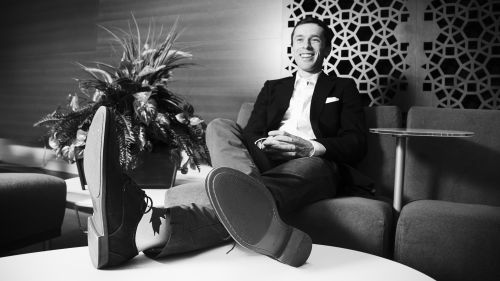
To someone in the humanities, the implications for studying the physics behind fast and efficient swimming fish are not quickly apparent. But Daniel Floryan, a second year doctorate student working in both Professor Clarence Rowley’s group, focused on flow control and Professor Alexander Smits’ group, focused on fluid dynamics, clarifies the implications of exploring these new waters.
Smits and Rowley are responsible for establishing a basic understanding of the physics involved in swimming fish to serve as the foundation for building underwater vehicles. In this case, the Navy identified this as a topic of fundamental interest and turned to the academic research community to focus on it, said Smits, whose group is interested in bio-inspired engineering – using nature as inspiration to lead to better engineered systems.
This project is part of a multidisciplinary research initiative, or MURI, which is a tri-service Department of Defense program that supports research teams whose efforts intersect more than one traditional science and engineering discipline. The project includes an interdisciplinary team of engineers, materials science researchers, and biologists from five universities. Smits and Rowley began work on the project in September 2014 and Floryan joined in the beginning of 2015.

Floryan came to Princeton in the fall of 2014 from Cornell, where he completed a Bachelor of Science in mechanical engineering, a Bachelor of Arts in economics and a minor in mathematics. Floryan’s oldest brother went to Cornell, so “that’s honestly the only reason I got to know about it; the best place to go for engineering and close enough to home so that I could go home for the holidays.” With an exposure to sciency things early on, Floryan decided to pursue mechanical engineering; he enjoyed fulfilling his liberal-arts requirement with economics enough to pursue a dual-degree.
Floryan said he partially pursued the economics degree because he thought of going into banking, but the more he got into it, he realized that it was not what he wanted to do. His research experiences had solidified his decision that graduate school was the most appropriate for him.
“Coming into Princeton, I didn’t know what lab I wanted to work in, but I knew that I was interested in fluid mechanics,” said Floryan. After speaking with professors in varying areas and discovering the projects they had available, Floryan wanted to work with Professor Smits for his experimental background and Professor Rowley for his computational and analytical techniques. He asked them to serve as his advisers, so he could approach his research from two different perspectives. Additionally, with Rowley and Smits working on the same [MURI] project, there was an obvious area of collaboration.
Having had Floryan in several of his classes, Smits knew he was an outstanding student and was happy to serve as his adviser: “He’s great. I’m at a stage in my career where I pick and choose and I would not take just any graduate student,” said Smits.
Joining the team solidified Floryan’s dissertation on elucidating the physics responsible for fast and efficient fish swimming.
While Floryan has not made up his mind on whether he wants to pursue a career in academia, industry, or start something up himself, he is currently fully immersed in his Princeton life. In addition to his research, he interacts with MAE undergraduates, both as an adviser and through playing intramural sports: “I love it,” says Floryan. “The undergrads here are very smart obviously, but what sets them apart is their enthusiasm.” Additionally, he mentors young students through lab demonstrations to groups such as the Harlem Prep to Princeton program and he sits on the MAE Committee on Climate and Inclusion.
“He’s a really promising young man, who is relatively early in his Ph.D. program,” said Smits. “I just expect great things from him. He’s already sounding like he has that instinct for research.”
With research comes the pressure to publish. Floryan is currently working on a paper with Smits on scaling propulsion for swimming fish. Smits and Floryan help each other, said Smits and describes their collaboration as a true team effort. He credits Floryan as the primary thinker on this paper because he identified the essential parameters that govern the performance of these kind of propulsors and expressed them in a very clear and understandable way.
Smits confirmed what a conversation with Floryan and his resume show, that he is a “terrific contributor and he’s a really deep-thinker.”
-Femke de Ruyter